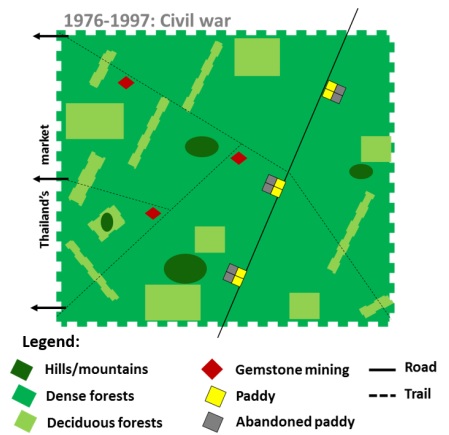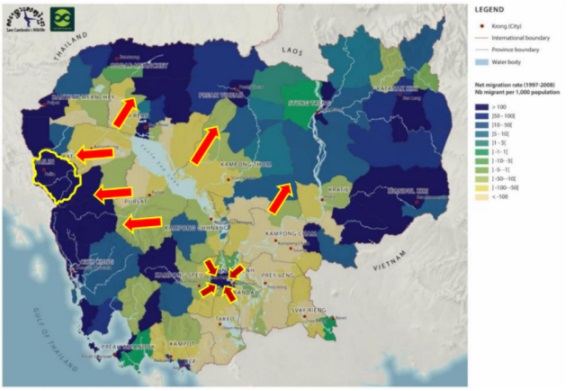In Laos, the agrarian transition is characterized by rapid changes in agricultural production systems. Since the early 2000s, a transition has been taking place, away from subsistence agriculture, primarily based on rice cultivation, forest gathering and extensive livestock farming, and towards market-oriented agricultural production systems, with a significant and rapid increase in crops grown for export (Figure 5.1) to neighbouring countries, mainly China, Thailand and Vietnam. This transition has been facilitated by the implementation of successive public policies to limit the use of shifting cultivation and to modernize agriculture (Box 5.1), and by the result of the country becoming
Accompanying the actors of the agroecological transition in Laos
AGROECOLOGY FUTURES
Agroecology is a big word. At AFD we use it all the time and we have for years. Often as a concept and a set of good practices we wish and hope to promote in the course of the five to ten years of the projects we finance as a donor agency. Also, as a reassurance that we are pushing agricultural development in the “South” away from some of the flaws, risks and downfalls (namely in environmental and social terms) of the “conventional” model of the “North”.
Practical handbook of direct seeding in Madagascar. Volume II.
In order to put in place a suitable advisory system, in an integrated approach at the terroir level, it is necessary to master a range of cropping systems adapted to local conditions. This requires identifying the nature of the most appropriate crops and the order of their succession and/or association, as well as the operational sequence to be applied to these crops or crop associations.
LULC PART I : Changes of land use and land cover
What is the term "land use" and "land cover" ? These terms often come together and are often erroneously used interchangeably; however, each term has a very specific meaning.
LULC PART II : Process of land use and land cover changes
Civil war and peace establishment (1976-2002) In-migration for land access (2002-2010) Turmoil of smallholder farming and future perspectives (2010-Future)
LULC PART III : Proximate causes, underlying factors, and their linkages
Proximate causes are human activities or immediate actions at the local level, such as agricultural expansion, that originate from intended land use and directly impact forest cover.
Des agriculteurs malgaches adoptent l'agro-écologie
A Madagascar, de nouvelles pratiques agricoles se mettent en place pour lutter contre les changements climatiques et préserver la sécurité alimentaire des familles. Le Fonds Français pour l’Environnement Mondial finance un projet de développement mis en œuvre par l’IRD, qui associe Agrisud International et des agriculteurs. Le film présente le partenariat entre recherche, ONG et population à travers la vie d’une famille malgache.
Towards an agroecological transition in Southeast Asia: Cultivating diversity and developing synergies
The world today is facing many challenges, among which demographic pressure and the natural resources of the earth, we are reaching the limits of. The demographic factor is directly linked with the food security issue since it is imperative that we produce more in order to feed our growing population. To this must be added the evolution of alimentary diet which accompany the progressive improvements we have seen in the lives of the poorest segments of the population. Having reached the outer physical limits of our planet, we can only intensify each farming acre’s productivity so as to preserve the natural areas still left to us, such as forests, while avoiding the non-sustainable development of marginal lands. When we include the stakes related to nutrition and climate change, it is easy to understand the complexity of the challenges facing us. This is particularly true in Southeast Asia due to the immense demographic pressure felt in most countries1.
L’agriculture climato-intelligente (ACI)
Le changement climatique va profondément modifier l’agriculture. En effet, à moins que des mesures ne soient prises rapidement, les changements de température et de précipitation, la hausse du niveau des mers et la fréquence croissante des événements climatiques extrêmes vont considérablement réduire la production alimentaire mondiale au cours de ce siècle. D’importants investissements privés et publics seront nécessaires.
L’agriculture de conservation pour l'intensification écologique : Principes et contraintes à l'adoption dans les pays du Sud
L’intensification écologique constitue un axe prioritaire des diverses institutions de recherche agronomique engagées dans la promotion de l’agriculture durable. Cependant, la conception de systèmes de production et leur mise en œuvre nécessitent des modifications profondes de l’organisation et des connaissances théoriques et techniques encore difficilement accessibles pour l’ensemble des acteurs de la recherche et du développement. Les cursus et supports pédagogiques sur le thème sont encore trop rares ou fragmentaires.







